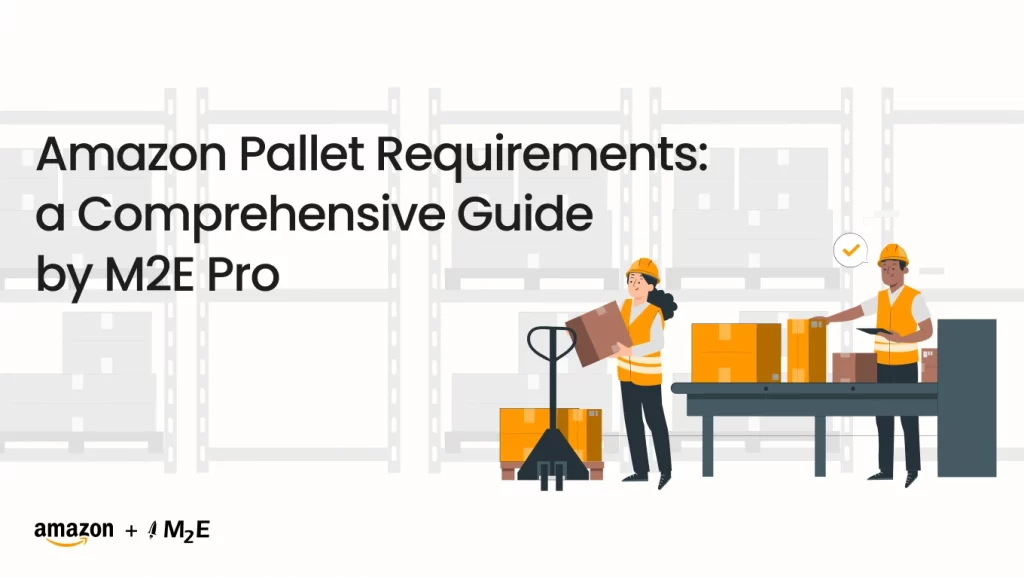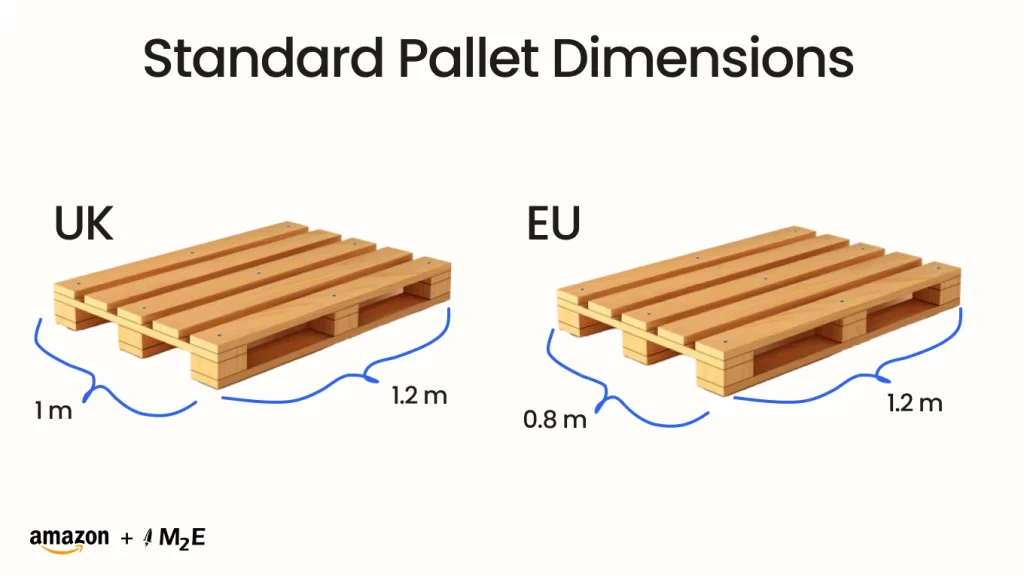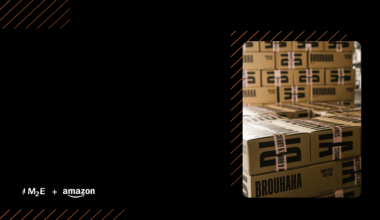
You might have heard about the pallet requirements of Amazon FBA before. Still, Amazon’s new pallet delivery program promises streamlined onboarding for MFN sellers, making it easier than ever to adopt efficient shipping methods. Why seize this opportunity? Early adopters of pallet delivery stand to attract more buyers who prefer this convenient shipping option. Dive into our article on M2E Pro to discover requirements, configuration tips, and operational insights to stay ahead of the curve.
What Does Amazon’s Pallet Delivery Program Entail?
The Amazon Pallet Delivery Program is a streamlined shipping solution designed for sellers to efficiently send large quantities. This program helps sellers meet Amazon’s logistical requirements, improving customer inventory management and delivery speed.
How to use this feature? M2E Pro now supports the Amazon Pallet Delivery program, allowing MFN (Merchant Fulfilled Network) sellers to consolidate and ship large orders on pallets. Enrolled sellers’ Business customers benefit from smoother inbound processing and delivery for bulk orders. When a customer selects Free Pallet Delivery at checkout, M2E Pro imports this detail into the Magento order, visible in the Shipping & Handling Information section on the Order View page.

When and Why Does Amazon Require Sellers to Use Pallets?
Amazon requires sellers to use pallets in specific scenarios, such as when shipping large quantities of products, handling heavy or bulky items, or sending multiple units of the same item.
By standardizing shipping methods, Amazon can maintain a streamlined and reliable logistics system, ultimately enhancing customer satisfaction with faster and more dependable deliveries.
When you should consider pallet options? There are several key factors:
- More than one unit is ordered.
- Each unit’s volume (cube) should not exceed 38 cubic feet.
- Each unit should weigh no more than 1250 pounds.
- The longest side of each unit must measure 5.7 feet or less.
- The second longest side of each unit should be 4 feet or less.
- The third dimension of each unit should not exceed 1.7 feet.
- Utilize at least 40% of pallet volume (30 cu. ft.) or 20% of pallet weight (500 lbs.).
How to Join Amazon’s Pallet Delivery Program?
Interested in enhancing your shipping options with Amazon’s pallet delivery program? Here’s your pathway to join:
- Review the guide: Delve into a guide to understand the program’s prerequisites and enrollment process thoroughly.
- Confirm eligibility: Ensure you can meet the following criteria:
- Ready to offer pallet delivery for qualifying ASINs, meeting predefined thresholds.
- Prepare to integrate the new Orders API endpoint tailored for pallet shipments.
- Provide SKU list: Compile a list of SKUs intended for enrollment in the pallet delivery program.
- Share API integration timeline: Provide an estimated timeline for integrating the Orders API to handle pallet orders seamlessly. Participating in this program allows you to offer customers the convenience of pallet delivery, potentially enhancing your sales and customer satisfaction. Also, M2E Pro supports Amazon’s Pallet Delivery program, streamlining shipping for MFN sellers handling bulk orders, visible in Magento’s Order View.
4-Step Essential Guide to Use Pallet
Step 1: Select the Appropriate Pallet
Selecting the right pallet size can be tricky due to the lack of an international standard. In the UK, standard dimensions are 1 x 1.2 meters, while in the EU, the average is 1.2 x 0.8 meters. Anyway, the Amazon UK pallet requirements standard is recommended to be 1 x 1.2 meters. Still, if you are considering how to sell on Amazon Europe, you can check out our blog.

Use strong, high-quality materials for your pallets for reliable support. Amazon suggests wooden pallets with 4-way entry, available in GMA (Grocery Manufacturers Association) standard A or B grades. Ensure pallets are in good condition, as damaged or weak materials reduce protection. Sturdy materials that resist bending or warping, such as triple-ply cardboard, are recommended to maintain shipment integrity.
Step 2: Arrange Your Items
When stacking pallets, it’s crucial to prioritize weight distribution for optimal stability and protection during transport. Start by placing the heaviest items at the bottom to support and safeguard lighter ones. Arrange boxes in vertical columns that interlock securely, ensuring they lie flat without overhanging the pallet by more than one inch. Fragile items should be strategically positioned towards the center to minimize the risk of damage, while sharp objects must be wrapped in protective padding to prevent punctures.
To further enhance stability, stagger the stacking pattern of boxes. Remember, the maximum height of stacked pallets should not exceed 90 cm (or approximately 1.8 meters for non-stacked configurations), adhering to safety guidelines. A standard pallet typically accommodates weights up to 2,000 kg, ensuring efficient handling and transportation.
It’s essential to adhere strictly to packaging requirements, particularly for hazardous materials, to avoid rejection and potential surcharges upon delivery to fulfillment centers.
Step 3: Package Your Shipment
To safeguard pallet loads during transit, it’s essential to wrap them securely with stretch film. For additional reinforcement, consider using bracing lumber, load protectors, edge boards, bands, or foam cushioning as necessary. Before wrapping, ensure that at least one label is prominently visible on each side of the load to facilitate identification.
Pallet Wrapping: Step-by-Step Guide:
- Step 1: Preparation Begin by pulling approximately one meter of stretch wrap from the roll and tuck the end into one corner of the pallet base. For example, if you’re shipping fragile electronics, consider using foam cushioning or corner protectors to prevent damage during transit.
- Step 2: Initial Wrapping Walk around the pallet, wrapping tightly around the base two times. As you move upwards in a spiral motion, maintain a minimum 50% overlap with each revolution. Every second rotation, twist the wrap to enhance its strength and stability. For instance, when shipping irregularly shaped items like furniture, use edge boards to provide stability and prevent shifting.
- Step 3: Top and Down Once you reach the top of the pallet, stretch the wrap over the corners, pulling down slightly to increase tension. Begin spiraling back down towards the base, ensuring each layer overlaps the previous one securely. Build up several layers around the base for added strength. For heavy items such as automotive parts, use bracing lumber or bands to reinforce the pallet’s structure.
- Step 4: Finishing Touch Tear off the stretch wrap and tuck the end securely under the edge of the pallet to prevent unraveling during handling and transportation. When shipping pallets with perishable goods like food items, ensure the wrap is tight to maintain freshness and prevent contamination.
For certain products, such as food items that need to breathe, consider using perforated wrap to allow for ventilation. You can read more about packaging here.
Step 4: Tag the Shipment
Once you’ve wrapped your pallet, it’s crucial to affix clear, easily readable labels on all four sides. If feasible, place labels inside each box for added visibility. For containers that shouldn’t be stacked, attach labels directly onto the items themselves. Remember to apply labels before wrapping to ensure they remain securely in place.
For LTL (Less Than Truckload) shipments via Amazon Freight, generate and print labels directly from the Amazon Freight website. Attach these labels securely to all four sides of the pallet to facilitate efficient processing and handling.
Once your shipment is labeled, wrapped, and stacked, it’s ready for pickup by Amazon Freight or their affiliated carriers. They’ll ensure prompt and secure transport, handling your shipment with care throughout its journey.
For instance, when shipping delicate electronics, ensure labels are securely attached inside each box to aid in quick identification and careful handling. For non-stackable items like machinery parts, affix labels directly onto the components before wrapping to maintain clear identification during transit.
By adhering to these labeling and pallet preparation guidelines, you can optimize the processing and handling of your shipments, ensuring smooth operations and timely availability of your products for customers on Amazon.
How to Schedule Pallet Delivery?
In Amazon Business, qualifying orders can benefit from ‘Pallet delivery‘ options, offering enhanced logistics flexibility. Here’s how to update your preferences:
- Navigate to your Amazon Business Settings and select Addresses.
- Choose the address where you want to manage pallet deliveries and click on ‘Edit delivery preferences’ from the Actions menu.
- Expand the ‘Pallet Preference’ section and select or deselect the checkbox for ‘Deliver on pallets when available’.
By adjusting these settings, you can tailor how pallet deliveries are handled for your orders, ensuring streamlined logistics that meet your business needs effectively.
Which shipping carriers are available for pallet delivery? To ship on pallets, you’ll need to use an LTL carrier. If you already work with an LTL carrier for your regular shipments, you can continue using them for pallet delivery. Amazon advises sellers to opt for integrated carriers to maintain a high Valid Tracking Rate (VTR). The list of integrated carriers is regularly updated on the Delivery Confirmation page.
Here’s how Amazon’s Pallet delivery option works:
- Checkout Option: If your order qualifies, you can select ‘Free Pallet delivery’ at checkout. By the way, with M2E Pro when a customer opts for Free Pallet Delivery during checkout, it automatically imports this information into the Magento order, making it visible in the Shipping & Handling Information section on the Order View page.
- Delivery Process: Your pallet will arrive shrink-wrapped with a packing slip attached.
- Delivery Notifications: You’ll receive delivery confirmation emails and notifications about any changes in delivery availability via email.
- Handling Without Receiving Dock: Even if your organization lacks a receiving dock or an adult available to receive the order, carriers use lift gates for delivery.
- Cost: There’s no additional charge for Pallet delivery.
- Returns: While damaged or unwanted items can be returned individually, Amazon does not support pallet pickups for returns. Refer to the Amazon Return Policy for details.
This service ensures convenient and efficient delivery of palletized orders for Amazon Business customers, enhancing logistics flexibility without extra costs.
Some pallet orders may let you choose a specific date and time for delivery. To schedule your pallet delivery:
- Sign in to your Amazon Business account.
- Add the eligible item to your Shopping Cart and proceed to checkout.
- Select a convenient date and time using the calendar, then place your order.
- After placing your order, your carrier will confirm the delivery date and notify you of any changes.
By the way, you can learn more about monitoring delivery preferences with M2E Pro on our blog.
Summary
Now you know how to ensure your pallets meet Amazon’s standards for efficient, hassle-free deliveries. Simplify your shipping process with our quick guide to Amazon’s pallet requirements and M2E Pro solution. Remember to check our blog for more e-commerce insights and tips.






